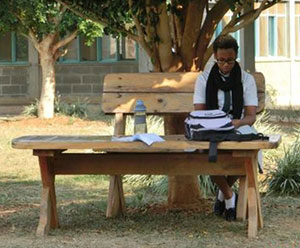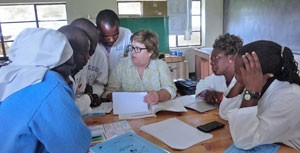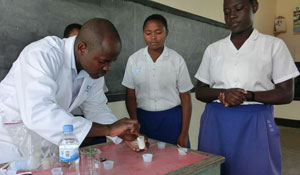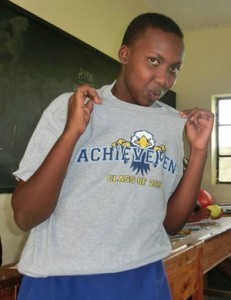With open eyes, beautiful moments are easy to find in Rwanda. That’s often a surprise to first-time visitors. Stories and images of the 1994 genocide from news reels and memoirs are many people’s only reference points. So, we’ve been moved by the distinctly different email updates that we’re receiving from Mothering Across Continents-supported volunteers who are in Rwanda right now. Beautiful flowers, a high school girl sitting under  a tree reading, a stroll up a cobblestone pathway. All are reminders that nature’s artistry, opportunities to quietly reflect, and a sense of connection are available around the world. So are examples of aspiration and leadership. A visit to Gashora Girls Academy, not far from the capital of Kigali, inspired US Physics teacher Deb Semmler’s breathless end-of-day reflection: “WOW! . . . Gashora is 3.2 miles down a dirt road on the edge of a beautiful lake. The
a tree reading, a stroll up a cobblestone pathway. All are reminders that nature’s artistry, opportunities to quietly reflect, and a sense of connection are available around the world. So are examples of aspiration and leadership. A visit to Gashora Girls Academy, not far from the capital of Kigali, inspired US Physics teacher Deb Semmler’s breathless end-of-day reflection: “WOW! . . . Gashora is 3.2 miles down a dirt road on the edge of a beautiful lake. The  students run the school. They make decisions on how the school operates, and they have pride. The three girls that we talked and walked around the school with have big dreams and are high achievers . . . We talked about the summer leadership program they are part of. This summer, 123 girls from around the world (50 from the US and Canada) are spending three weeks learning about leadership and girl power.” As Deb has commented more than once on her experience in Rwanda, “A great day in Africa.”
students run the school. They make decisions on how the school operates, and they have pride. The three girls that we talked and walked around the school with have big dreams and are high achievers . . . We talked about the summer leadership program they are part of. This summer, 123 girls from around the world (50 from the US and Canada) are spending three weeks learning about leadership and girl power.” As Deb has commented more than once on her experience in Rwanda, “A great day in Africa.”
Tag Archives: Science education
Science Education for Girls in Rwanda
It’s been awhile since we posted a blog on our website. Physics teacher Deb Semmler’s trip to Rwanda makes it worth starting up again. Through Mothering Across Continents, she is guest teaching and providing professional development training for physics, chemistry and biology teachers for nearly three weeks. It’s her first trip to Africa.
 I’m at an all-girls high school that we call “Biyimana” for short. The school, managed by nuns, was founded in 1955 with the first class graduation in 1959. The school is very well-established and they raise cows to provide fresh milk for the students, as well as chickens for eggs, pigs, and rabbits to sell to provide beef for students. They have large gardens that provide fruits and vegetables for the students, including carrots, beets, and bananas. They seem fully self-supporting and have men who tend to the livestock and gardens. Nobody wants for food here, and there is no food desert as far as I can tell. I see fresh fruit and vegetable at every meal and available along the “road” as we drive to and from the school. I drank warm fresh milk for the first time ever at lunch (so far, so good, not sick).
I’m at an all-girls high school that we call “Biyimana” for short. The school, managed by nuns, was founded in 1955 with the first class graduation in 1959. The school is very well-established and they raise cows to provide fresh milk for the students, as well as chickens for eggs, pigs, and rabbits to sell to provide beef for students. They have large gardens that provide fruits and vegetables for the students, including carrots, beets, and bananas. They seem fully self-supporting and have men who tend to the livestock and gardens. Nobody wants for food here, and there is no food desert as far as I can tell. I see fresh fruit and vegetable at every meal and available along the “road” as we drive to and from the school. I drank warm fresh milk for the first time ever at lunch (so far, so good, not sick).
The teachers use questioning and have students individually go to the board, do the work, and explain each step of a problem or question to the others. They use science note booking for taking notes and doing problems (two separate books). The students’ notebook are impeccable, using ink and rulers to draw. They don’t make mistakes and have perfect handwriting.
One morning, I did professional development training with 2 biology teachers, 2 chemistry teachers and one physics teacher. We started with the hydrophilic bead that I had left in water overnight . . . with the coin that is invisible when there is no excess water and visible with excess water due to light refraction in the air space.
 I made a short presentation using the projector on the newest research on how people learn, not by reading and rereading but by testing themselves overtime. That led me to show them how we use “foldables” so students can take notes and test their knowledge over time. The teachers separated into subject groups and made their own. One bio teacher one a foldable of fungi. The other made one on the difference between DNA and RNA. The chemistry teachers made one on acids and bases. I worked with the physics teacher on some of the physics specific material (FCI and graphing diagnostic) and computer documents that I am sharing. I showed the chemistry teacher the acid/base pH PhEt interactive lab that shows the same thing as doing an actual lab. We did a pH lab with the NaOH and pH paper I brought and transmission of disease lab.
I made a short presentation using the projector on the newest research on how people learn, not by reading and rereading but by testing themselves overtime. That led me to show them how we use “foldables” so students can take notes and test their knowledge over time. The teachers separated into subject groups and made their own. One bio teacher one a foldable of fungi. The other made one on the difference between DNA and RNA. The chemistry teachers made one on acids and bases. I worked with the physics teacher on some of the physics specific material (FCI and graphing diagnostic) and computer documents that I am sharing. I showed the chemistry teacher the acid/base pH PhEt interactive lab that shows the same thing as doing an actual lab. We did a pH lab with the NaOH and pH paper I brought and transmission of disease lab.
 The chemistry teacher asked if I could make the electrolytic cell lab he had in his notes, using a battery and two conducting probes. We made it work with the conductivity tester I brought, and he used it in his classroom along with the pH paper test with salt (NaCl), pure water and a strong base (NaOH). The students did the tests and shared results. These are excellent teachers. They just need resources! Sometimes language is a barrier, so it’s been suggested that students write notes to our students at East Mecklenburg High, and our students write back. I also asked how we could bring 6 to 10 visiting teachers and students here, and transfer them from the hotel to the school along the rough road. transfer many. The answer is to rent a state operated bus and driver.
The chemistry teacher asked if I could make the electrolytic cell lab he had in his notes, using a battery and two conducting probes. We made it work with the conductivity tester I brought, and he used it in his classroom along with the pH paper test with salt (NaCl), pure water and a strong base (NaOH). The students did the tests and shared results. These are excellent teachers. They just need resources! Sometimes language is a barrier, so it’s been suggested that students write notes to our students at East Mecklenburg High, and our students write back. I also asked how we could bring 6 to 10 visiting teachers and students here, and transfer them from the hotel to the school along the rough road. transfer many. The answer is to rent a state operated bus and driver.
This is why I am here! These teachers, like most I know, love their students and work very hard to help them be successful. The headmistress watched the whole physics class and was very happy to see the students engaged.

